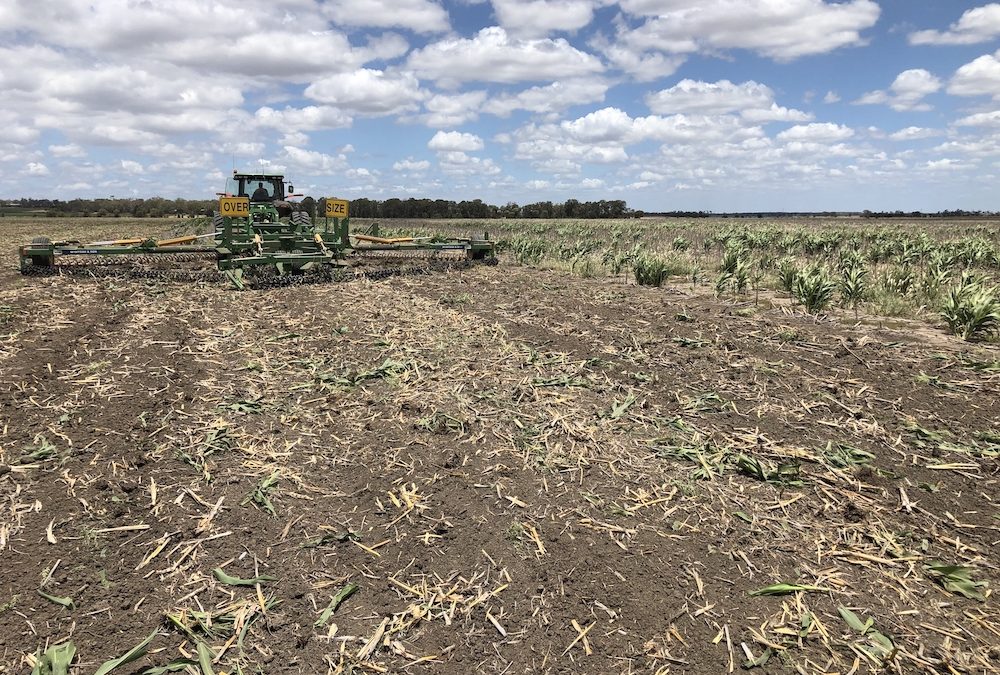Cutting Back on Herbicide
Controlling weeds with the KELLY Tillage System
KELLY Tillage System Case Study
Farmer: Lance Wise, Queensland
Farm size: approx. 1650ha, black clay and red ridge soils
Crops grown: sorghum, wheat, barley, chickpeas, mung beans
Kelly model: 30ft/40ft with CL1, CL2 and Spiked Disc
On the Darling Downs
Lance Wise farms 1650 hectares on Queensland’s Darling Downs. The farm grows sorghum, wheat, barley, chickpeas and mung beans, all of which are cropped for grain.
Though production varies from season to season, yields average 4t/ha yield for sorghum, 2t/ha for wheat and barley, 1.5t/ha for chickpeas and 1t/ha for mung beans.

Photo: Sorghum growth before and after levelling
The farm uses dryland cropping, and has soil ranging from self-mulching black vertisols to chocolate-red ferrosols. Wise doesn’t plant cover crops.
Common weeds on the Wise farm include fleabane, feathertop Rhodes grass, urochloa, yellow vine and cow vine. The weeds are generally treated by spraying, with resilient weeds being killed by a pass with a Kelly harrow.
Wise uses shallow tillage to smash and incorporate field stubble, pull weeds after spraying and level ruts left in the field. The Wise farm uses controlled traffic farming, with 3 metre wheel tracks and 12.2-metre swaths.

Photo: Lance Wise (left) with his 30ft Kelly Diamond Harrow
Using the Kelly
Lance Wise has four Kelly harrows (two 30ft and two 40ft models), which he uses on his own farm as well as renting them out to others as part of his dry hire business. Two machines (one of each model) are fitted with CL1 Disc Chain front and rear, for a more moderate and versatile approach. The other two machines have CL2 Disc Chain front and Spiked Disc Chain on the rear; the sharp-edged CL2 discs provide more aggressive weed control, while the spiked discs leave a coarser finish which is more resistant to erosion. Lance Wise feels that the CL2/ Spiked Disc combination is the best fit for his farm’s soils.

Photo: Spiked Disc Chain on black clay soil
Depending on the chain type, Wise’s Kelly harrows run at between 11 and 12.5km/h and work 12-15ha per hour. Fuel use is generally between 2-3L/ ha. The machines require minimal maintenance, admits Wise, who says that he “just greases as needed.” He feels that the Kelly harrow is at its best in dry soils. “It’s suited to drier conditions for sure, but can still be used fairly wet if needed,” says Wise.
Overall, Wise feels that the Kelly harrow works well in conjunction with his farm’s sustainable agriculture practices, and that at times it “works hand in hand” with other machines.
Weed Control
| Lance Wise first purchased a Kelly harrow as a way to supplement his weed control. He uses the disc chain together with herbicide as a cheap ‘double knock’ that doesn’t contribute to chemical resistance. This process helps him to kill a higher percentage of weeds at a lower cost.
The Kelly harrow has been effective at controlling herbicide resistant feathertop Rhodes grass and fleabane, especially on Wise’s black clay soils. Wise has found that the Kelly harrow kills 85-90% of weeds when used before spraying herbicide. After a light spray though, weed kill goes up to 99%. Since integrating the Kelly into his weed control program Wise has been able to cut out a total of 3-4 sprays per year and weed pressure on his farm has decreased significantly. |
 |
One Tool, Many Uses
The Kelly Diamond Harrow plays a key role in multiple sustainable processes on the Wise farm. It’s used to incorporate stubble into the topsoil, retaining carbon and minimising the loss of organic matter. In the same pass, the Kelly harrow pulls out 85-90% of weeds, reducing the need for herbicides.
Wise also uses the Kelly harrow to help soil moisture levels. Improving water retention is the biggest challenge for Wise, who has begun to use sub-soil ripping to increase water holding capacity. By working to a depth of 35-40cm, he’s been able to improve moisture levels in the soil and break up compaction. The Kelly harrow aids in this process by levelling the field after ripping, mitigating damage to the seedbed and increasing the filth.

Photo: Fleabane pulled out by the roots
Key Findings
- A combination of shallow surface tillage and sub-soil ripping has led to reduced weed pressure and increased water retention.
- An integrated approach to weed control has reduced weed pressure and allowed Wise to cut out 3-4 sprays each season.
- Levelling the seedbed with a Kelly harrow has increased working speed for all field operations.
- Managing stubble with the Kelly harrow has led to improvements in crop establishment.
Contact Kelly Engineering for more information about the KELLY Tillage System
Data for this case study was provided by Lance Wise and collated by Kelly Engineering



